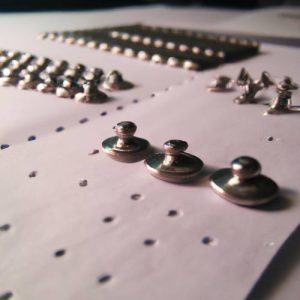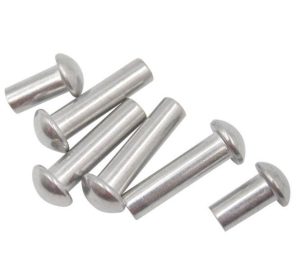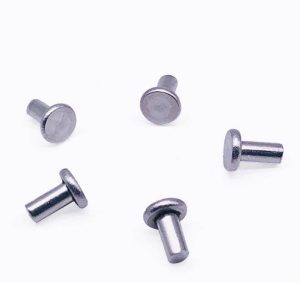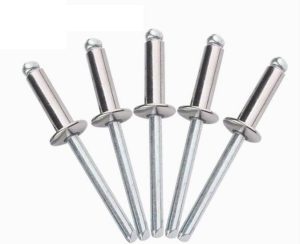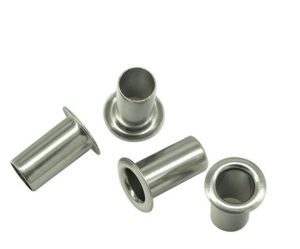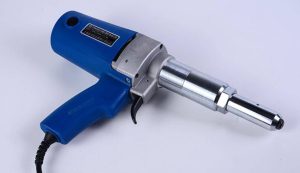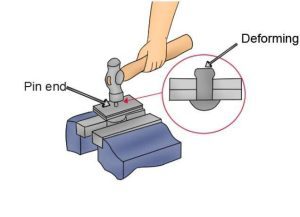Non-structural Rivets
Non-structural rivets, on the other hand, are used for plastic, fabric, and thin sheet metal because of their small weight. They find widespread application in the production of furniture, clothing, and bags. Common types include blind rivets, tube rivets, drive rivets, and solid rivets.
(1)Blind rivets
Blind rivets are sometimes known as pop rivets, after the sound they make when they are set. Because just one side of a material can be worked with, they are often used in the automotive and construction sectors.
(2)Tubular rivets
Tubular rivets are used instead of solid rivets when the materials being joined are too flimsy to withstand their weight. They find widespread use in electronic and electrical applications, as well as leather goods like handbags and belts.
(3)Drive Rivets
Drive rivets are designed to be used in applications that don’t necessitate expensive machinery. They are typically hammered into place for use in home and vehicle repairs.
(4)Solid Rivets
Fasteners don’t get more tried-and-true than solid rivets. They have widespread application in fields such as construction and aeronautical engineering, where exceptional durability is essential.
Choosing the Right Type of Rivet
Selecting the appropriate type of rivet is critical to the success of any project. When choosing a rivet, numerous aspects must be considered, including the materials used to produce the rivet, the size and shape of the rivet, and the strength needs of the project.
The materials used to create the rivet can affect its performance in various conditions. Aluminum rivets, for example, are lightweight and corrosion-resistant, making them excellent for use in aircraft and maritime applications. Steel rivets, on the other hand, are stronger and better suited to heavy-duty applications.
The size and shape of the rivet are other critical variables. The thickness of the materials being bonded should be used to determine the size of the rivet. The shape of the rivet head can also vary, with dome heads and countersunk heads being the most prevalent.
Another consideration when selecting a rivet is its strength. The strength of the rivet should be sufficient to sustain the load or stress applied on the junction. While choosing a rivet, consider vibration, impact, and temperature fluctuations.
Ultimately, the key to choosing the proper type of rivet is to thoroughly examine the project’s specific requirements and choose a rivet that is most suited to meet those demands. By doing so, you can secure a robust and dependable joint that will last for many years.
Tools for Riveting
Now that you’ve learned about the various types of rivets, let’s speak about the tools you’ll need to correctly install them. Rivet guns and hand tools are the two most commonly utilized riveting tools.
Rivet guns are power tools that are utilized in high-volume or industrial applications. They come in a variety of sizes and types, ranging from air-powered pistols to cordless variants. Consider the size and type of rivet you intend to use, as well as the thickness of the materials being joined, before choosing a rivet gun.
Hand Tools: Hand tools are an excellent choice for minor projects or DIY work. They are inexpensive, simple to operate, and portable. Pliers, hammers, and rivet punches are examples of hand tools used for riveting. As with rivet guns, consider the size and kind of rivet you intend to use, as well as the thickness of the materials to be bonded.
It is vital to note that different types of rivets may necessitate the use of different tools. Blind rivets, for example, frequently necessitate the use of a specialized tool known as a blind rivet setter. Before commencing your job, make sure to investigate the specific tools required for the type of rivet you intend to use.
Understanding the various riveting equipment allows you to select the proper tools for your project and ensure a flawless installation.
How to Rivet your workpiece properly
Now that you’ve chosen the right sort of rivet for your project and obtained the essential tools, it’s time to learn how to rivet your workpiece properly. The strategies listed below will walk you through the process step by step:
Prepare the workpiece: Before you begin, make sure it is clean and clear of debris. Drill holes in the materials that will be linked together if necessary.
Install the rivet: Insert the rivet through the holes in the joining materials. Insert the rivet through the workpiece from the other side of the head, with the tail extending outwards, if using a solid rivet.
Set the rivet: Using your preferred riveting tool, draw the tail of the rivet into the hole while squeezing the head of the rivet. The tail will grow as a result, binding the components together.
It is vital to note that the approach utilized will differ based on the type of rivet and tool used. For the greatest results, always follow the manufacturer’s recommendations.
In addition to the fundamental procedure described above, there are variations such as blind riveting and tubular riveting that necessitate the use of specialized tools and techniques. Blind riveting, for example, entails installing a rivet that can only be set from one side of the workpiece.
Conclusion
Following these guidelines and carefully setting your rivets will guarantee a strong and durable joint for your work.
Because of its useful features, riveting is widely used in several industries. While choosing a rivet, it is important to consider the materials, size, shape, and strength requirements of the intended use.
Having the right tools is crucial for effective riveting. It is crucial to select the appropriate equipment, such as rivet guns and hand tools, for this task.
In addition, the quality and durability of the final product can be greatly improved by mastering the techniques of preparing the workpiece, inserting the rivet, and setting it.
We hope you’ve found our guide to rivets and their uses to be informative. We encourage you to try out several types and methods of riveting to find what works best for your undertaking. Prioritize safety first and always read and follow labels and instructions. The capacity to fascinate an audience can develop into a valuable skill with practice.


